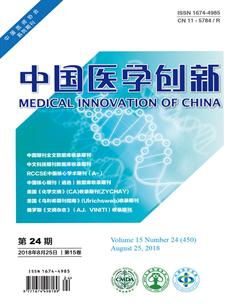信号通路介导乳腺癌内分泌治疗耐药的研究进展
范凤凤 郭宇
【摘要】 乳腺癌内分泌治疗作为乳腺癌综合治疗的方法之一,具有不可替代的重要性。然而,原发性和继发性耐药仍是内分泌治疗中面临的难题。文章旨在对介导乳腺癌内分泌耐药的信号通路及临床试验中靶向治疗的进展进行综述,为临床内分泌治疗提供新的方向。
【关键词】 乳腺癌; 内分泌治疗; 耐药; 靶向治疗
【Abstract】 Endocrine therapy for breast cancer as one of the methods of comprehensive treatment of breast cancer has irreplaceable importance.However,primary and secondary drug resistance is still a difficult problem in endocrine therapy.The purpose of this article is to review the signal pathway of mediating endocrine resistance in breast cancer and the progress of targeted therapy in clinical trials in order to provide a new direction for clinical endocrine therapy.
【Key words】 Breast cancer; Endocrine therapy; Drug resistance; Targeted therapy
First-authors address:Medical School of Ningbo University,Ningbo 315000,China
doi:10.3969/j.issn.1674-4985.2018.24.040
乳腺癌是全球范围内女性发病率最高的恶性肿瘤,持续升高的发病率和死亡率,严重危害了女性的生命和健康。据统计,有60%~75%的浸润性乳腺癌患者分子分型为激素受体阳性,故内分泌治疗(endocrine therapy,ET)对这类患者而言是十分重要的治疗方式[1]。内分泌治疗,与化疗相比毒性低,且较易耐受,成效显著,明显降低了激素受体阳性乳腺癌患者的复发率[2-3]。但是,并非所有的激素受体阳性患者对内分泌治疗敏感,一部分患者可表现为原发或继发性耐药,从而导致肿瘤进展或复发。研究表明,多种生长因子信号通路的激活、雌激素受体的表达及功能异常、肿瘤微环境的改变等异常均能导致乳腺癌内分泌治疗耐药[4-5]。本文综述了介导乳腺癌内分泌耐药的信号通路及临床试验中靶向治疗的效果,以期为ER阳性乳腺癌治疗提供新对策。
1 信号通路
1.1 PI3K/Akt/mTOR信号通路 PI3K/Akt/mTOR信号通路是细胞内的重要信号通路,在调节肿瘤细胞的增殖、分化、转移过程中发挥重要作用,该信号通路的激活与乳腺癌的發生和发展有密切关系[6]。PI3Ks家族蛋白可分为Ⅰ、Ⅱ、Ⅲ类。PI3K被激活后的产物与Akt的PH区结合,激活Akt后进一步激活下游的因子,下游mTOR的活性因而增强,使ER磷酸化,形成耐药细胞。mTOR是一类丝氨酸/苏氨酸蛋白激酶,是PI3K/Akt信号通路下游的重要效应分子,mTOR可接受上游来自Her-2、IGFR、EGFR等生长因子受体的信号,引起PI3K/Akt/mTOR信号通路激活,mTOR的表达上调,调控了肿瘤细胞的增殖、分化和转移,导致继发性内分泌耐药[7]。PI3K/Akt/mTOR信号通路的激活除上游信号传递外,PI3K突变和PTEN丢失也是重要原因。联合分析9项研究表明,在激素受体阳性/HER-2阴性的乳腺癌中,PI3CA突变率最高,达到37%。有研究表明,内源性Akt在他莫昔芬治疗失败的乳腺癌细胞MCF-7中表达增强,引起乳腺癌细胞ER表达缺失,导致内分泌治疗耐药;反之,抑制PI3K或Akt的活性可增强ER表达,使细胞对内分泌治疗药物的敏感性恢复[8]。
1.2 HER-2信号通路 研究表明,HER-2信号通路与ER通路之间存在交互通话的现象,HER-2过表达者往往伴随ER阴性,而ER阳性组的HER-2阳性率显著低于ER阴性者,HER-2阳性的患者内分泌治疗反应低下。激素受体阳性和HER-2过表达患者的其中一条信号通路受抑制,会激活另一条通路,同时抑制ER和HER-2两条通路更有效[9]。HER-2通路的激活,引起下游ERK1/2MAPK超活化,可干预ER与其共调节因子结合,降低ER表达水平,甚至诱导ER表达缺失[10]。Osborne等[11]的体外实验也证实了ER同HER-2信号转导途径的交互作用与内分泌治疗耐药有关。生长因子激活HER-2信号通路后,同时激活特异性的蛋白激酶,使位于或靠近细胞膜的ER与生长因子的激酶受体结合并活化,活化的ER移至细胞核内与DNA结合,通过转录和翻译,产生相应的功能蛋白,使肿瘤细胞增殖,内分泌治疗失败。
1.3 丝裂原活化蛋白激酶(mitogen-activated protein kinase,MAPK)信号通路 MAPK激酶是细胞增生和凋亡信号转导的关键蛋白激酶,在不同的信号转导途径中均有表达。MAPK信号通路是细胞生物信号传导通路中的重要一员,促进细胞的分裂、增殖和分化,与肿瘤进展和药物耐药密切相关[12]。MAPK主要包括ERK1/2、JNK、P38、和ERK5四条通路,其中ERK1/2通路是MAPK信号转导系统的经典通路。其信号通路由RAF丝氨酸/苏氨酸激酶启动,激活MAPK信号通路后,诱导ER的AF-1区的主要位点,如Ser118、Ser167磷酸化,从而使对ER敏感的基因表达上调,诱导内分泌治疗耐药细胞的生长和增殖。Brodie等[13]利用来曲唑耐药乳腺癌细胞LTLTCa,得出来曲唑耐药细胞ER磷酸化水平明显高于来曲唑敏感细胞的结论,细胞系中p-Raf、HER-2、p-MAPK及p-MEK1/2表达上调,证实了ER与HER-2信号通路相互影响,使MAPK信号通路激活,从而诱导ER磷酸化,促进乳腺癌细胞增殖。
2 靶向药物在逆转乳腺癌内分泌治疗耐药中的研究进展
2.1 mTOR抑制剂 mTOR抑制剂依维莫司与mTOR1结合阻断mTOR,相关临床研究表明其与内分泌联合治疗在晚期内分泌耐药乳腺癌中显示出明显的获益[14]。TAMRAD Ⅱ期临床试验目的是比较他莫昔芬单药与他莫昔芬联合依维莫司疗效的差异[15],该研究入组111例既往芳香化酶抑制剂(AIs)辅助治疗失败的激素受体阳性/HER-2阴性的绝经后转移性乳腺癌患者,结果表明,治疗6个月后,他莫昔芬联合依维莫司组的临床获益率为61%,明显高于他莫昔芬单药组的42%(P=0.045);联合组的疾病进展时间为8.6个月同样优于单药组的4.5个月(P=0.002),亚组分析示原发性芳香化酶抑制剂耐药组的疾病进展时间两组之间比较,差异无统计学意义(5.4个月 vs 3.8个月,P>0.05),然而对于继发耐药组的患者,他莫昔芬联合依维莫司组和单药治疗组的疾病进展时间为分别为14.8个月vs 5.5个月(P=0.008 7),临床获益率显著增高。BOLERO-2是依维莫司获批乳腺癌适应证的关键性Ⅲ期临床试验[16],试验再次验证了依维莫司联合内分泌治疗在既往内分泌治疗失败的激素受体阳性晚期乳腺癌患者中的有效性。该研究纳入724例激素受体阳性HER-2阴性晚期乳腺癌患者,特征为经芳香化酶抑制剂(来曲唑或阿那曲唑)治疗后出现进展复发,研究结果发现,依维莫司联合依西美坦组与依西美坦加安慰剂组相比中位无进展生存期(PFS)明显延长[11个月vs 4.1个月,HR=0.38,95%CI(0.31,0.48),P<0.001],总缓解率和临床获益率(两者分别为12.6% vs 1.7%,51.3% vs 26.4%)也占显著优势。
2.2 PI3K抑制剂 文献[17]研究表明,PI3K抑制剂能阻止内分泌治疗耐药的发生。Buparlisib(BKM120)是一种口服的泛Pan-PI3K抑制剂,BELLE-2为随机双盲安慰剂对照 Ⅲ期研究,研究纳入1 147例绝经后激素阳性/HER-2阴性局部晚期或转移性乳腺癌患者,均为芳香化酶抑制剂治疗中或治疗后≤1年内出现复发或转移,根据PI3K通路的状态和是否有内脏转移进行分层,受试者被随机分配到Buparlisib(100 mg/d)联合氟维司群(500 mg)组和安慰剂联合氟维司群(500 mg)组。Buparlisib联合氟维司群组和氟维司群联合安慰组的中位PFS分别为6.9个月和5.0个月(HR=0.78,P<0.001),显示了一定的PFS获益[18-19]。但由于该药能通过血脑屏障的特性,造成了一系列不良反应,如焦虑、抑郁等[20-22],故目前尚未批准用于临床。
2.3 HER-2抑制剂 HER-2过表达在内分泌原发耐药中占重要地位,激素受体阳性HER-2阳性的乳腺癌患者中,内分泌联合HER-2抑制剂同样为提高内分泌治疗的有效方法之一。随机3期TAnDEM研究目的是比较曲妥珠单抗联合阿那曲唑与阿那曲唑加安慰剂两组的疗效[23],EGF30008研究比较了拉帕替尼抗HER-2治疗联合来曲唑与来曲唑加安慰剂两组的疗效[24],两个试验均是双重阻断ER和HER-2通路,与单阻断ER通路相比,PFS有明显改善,但是OS的改善不明显。这两项临床试验一致的结果是对于绝经后激素受体阳性HER-2阳性的复发转移患者,AI单药效果欠佳,对于既往内分泌治疗失败的激素受体阳性HER-2阳性的乳腺癌患者,为了逆转内分泌治疗耐药,在内分泌治疗基础上进行抗HER-2治疗是非常必要的。
2.4 CDK4/6抑制剂 细胞周期蛋白依赖性激酶(CDK)对细胞周期调控有重要作用,研究表明,抑制CDK4/6的活性,乳腺癌细胞增殖同样受抑制[25],与内分泌治疗联合可逆转内分泌耐药。帕布昔利布(Palbociclib)是一种CDK4/6抑制剂,通过阻断细胞周期从G1向S1期过渡,从而阻断肿瘤细胞增殖[26]。随着PALOMA-1、PALOMA-3和PALOMA-2临床试验结果的先后公布,明确了Palbociclib能延缓或逆转内分泌耐药,确立了联合内分泌双重治疗在HR/HER-2阴性晚期乳腺癌的重要地位[27-28]。
2.5 恩替诺特(entinostst) 组蛋白去乙酰酶复合体(HDAC)是雌激素转录复合物的关键组成部分,临床前研究提示,HDAC抑制剂通过上调ER?表达或调节生长信号通路逆转人ER?阳性乳腺癌细胞株,可逆转激素受体阳性乳腺癌他莫昔芬/AI耐药[29]。现已确认某些特异性HDACs在乳腺肿瘤中异常表达[30]。ENCORE 301 Ⅱ期临床试验纳入130例绝经后非甾体AIs耐药的晚期激素受体阳性乳腺癌患者,随机分为依西美坦联合恩替诺特组和依西美坦联合安慰剂组,主要终点PFS分别为4.3个月和2.3个月(P=0.05),OS分别为28.1个月和19.8个月(P=0.036)[31]。基于上述结果,恩替诺特被美国FDA授予突破性疗法认定的新药[32],作为FDA加速新药研发上市的重要途径。
2.6 EGFR抑制剂 研究表明,当细胞内EGFR表达水平明显增高时,细胞膜上的ER能够激活EGFR/HER-2信号通路,从而导致内分泌耐药。吉非替尼是选择性EGFR的受體酪氨酸激酶抑制剂,通过阻断EGFR与ER的相互作用途径,抑制MAPK信号转导,达到逆转他莫昔芬耐药的目的[33]。NCT00077025 Ⅱ期临床试验中,入组了93例他莫昔芬治疗后耐药的绝经后晚期乳腺癌患者,随机分为两组(阿那曲唑联合吉非替尼组和阿那曲唑联合安慰剂组),结果显示,与阿那曲唑联合安慰剂组相比,联合吉非替尼组的临床获益率明显增高,无病进展时间显著延长,分别为14.6个月比8.2个月(HR=0.55),但是尚未有明确的大样本临床获益证据,仍需前瞻性多中心研究进一步求证[34]。
内分泌治疗耐药是乳腺癌治疗中一个尚未攻克的难题,如何逆转或延缓内分泌治疗耐药是目前乳腺癌治疗研究的重点之一。期待在不久的将来,找到新的治疗机制以及靶向药物的多药联合治疗方案,能显著着提高乳腺癌内分泌治疗耐药患者的疗效。
參考文献
[1]中国乳腺癌内分泌治疗专家共识专家组.中国乳腺癌内分泌治疗专家共识(2015版)[J].中国癌症杂志,2015,25(9):755-760
[2] Cancer Genome Atlas Network.Comprehensive molecular portraits of human breast tumours[J].Nature,2012,490(7418):61-70.
[3] Coates A S,Winer E P,Goldhirsch A,et al.Tailoring therapies-improving the management of early breast cancer: St Gallen International Expert Consensus on the Primary Therapy of Early Breast Cancer 2015[J].Ann Oncol,2015,26(8):1533-1546.
[4] Ziauddin M F,Hua D,Tang S C.Emerging strategies to overcome resistance to endocrine therapy for breast cancer[J].Cancer Metastasis Rev,2014,33(2-3):791-807.
[5] Fan W,Chang J,Fu P.Endocrine therapy resistance in breast cancer:current status,possible mechanisms and overcoming strategies[J].Future Med Chem,2015,7(12):1511-1519.
[6] Chia S,Gandhi S,Joy A A,et al.Novel agents and associated toxicities of inhibition of the pi3k/Akt/mtor pathway for the treatment of breat cancer[J].Curr Oncol,2015,22(1):33-48.
[7] Provenzano A,Kurian S,Abraham J.Overcoming endocrine resistance in breast cancer:role of the PI3K and the mTOR pathways[J].Expert Rev Anticancer Ther,2013,13(2):143-147.
[8] Ciruelos Gil E M.Targeting the PI3K/AKT/mTOR pathway in estrogen receptor-positivebreast cancer[J].Cancer Treat Rev,2014,40(7):862-871.
[9] Hurtado A,Holmes K A,Geistlinger T R,et al.Regulation of ERBB2 by oestrogen receptor-PAX2 determines response to tamoxifen[J].Nature,2008,456(7222):663-666.
[10] Knowlden J M,Hutcheson I R,Jones H E,et al.Elevated levels of epidermal growth factor receptor/c-erbB2 heterodimers mediate an autocrine growth regulatory pathway in tamoxifen-resistant MCF-7 cells[J].Endocrinology,2003,144(3):1032-1044.
[11] Osborne C K,Schiff R.Growth factor receptor Cross-talk with estrogen receptor as a mechanism for tamoxifen resistance in breast cancer[J].Breast,2003,12(6):362-367.
[12] Holohan C,Van Schaeybroeck S,Longley D B,et al.Cancer drug resistance:an evolving paradigm[J].Nat Rev Cancer,2013,13:714-726.
[13] Brodie A,Jelovac D,Sabnis G,et al.Model systems: mechanisms involved in the loss of sensitivity to letrozole[J].
J Steroid Biochem Mol Biol,2005,95(5):41-48.
[14] Lui A, New J, Ogony J, et al. Everolimus downregulates estrogen receptor and induces autophagy in aromatase inhibitor-resistant breast cancer cells[J].Bmc Cancer,2016,16:487.
[15] Bachelot T,Bourgier C,Cropet C,et al.Randomized phase Ⅱ trial of everolimus in combination with tamoxifen in patients with hormone receptor-positive, human epidermal growth factor receptor 2-negative metastatic breast cancer with prior exposure to aromatase inhibitors:a GINECO study[J].J Clin Oncol,2012,30(22):2718-2724.
[16] Yardley D A,Noguchi S,Pritchard K I,et al.Everolimus plus exemestane in postmenopausal patients with HR+ breast cancer:BOLERO-2 final progression-free survival analysis[J].Adv Ther,2013,30(10):870-884.
[17] Crowder R J,Phommaly C,Tao Y,et al.PIK3CA and PIK3CB inhibition produce synthetic lethality when combined with estrogen deprivation in estrogen receptor-positive breast cancer[J].Cancer Res,2009,69(9):3955-3962.
[18] Maira S M,Pecchi S,Huang A,et al.Identification and characteriza tion of NVP-BKM120, an orally available pan-class Ⅰ PI3-kinase inhibitor[J].Mol Cancer Ther,2012,11(2):317-328.
[19] Baselga J,Campone M,Osborne K,et al.PI3K inhibitor improves PFS in BELLE-2 trial[J].Cancer Discov,2016,6(2):115-116.
[20] Bendell J C,Rodon J,Burris H A,et al.Phase Ⅰ,Dose-Escalation Study of BKM120, an Oral Pan-Class Ⅰ PI3K Inhibitor,in Patients With Advanced Solid Tumors[J].Journal of Clinical Oncology,2012,30(3):282-290.
[21] Hong D S,Bowles D W,FalchookK G S,et al.A multicenter phase I trial of PX-866,an oral irreversible phosphatidylinositol 3-kinase inhibitor,in patients with advanced solid tumors[J].Clin Cancer Res,2012, 18(15):4173-4182.
[22] Bowles D W,Ma W W,Senzer N,et al.A multicenter phase 1 study of PX-866 in combination with docetaxel in patients with advanced solid tumours[J].British Journal of Cancer,2013,109(5):1085-1092.
[23] Kaufman B,Mackey J R,Clemens M R,et al.Trastuzumab plus anas trozole versus anastrozole alone for the treatment of postmenopausal women with human epidermal growth factor receptor 2-positive,hormone receptor-positive metastatic breast cancer:results from the randomized phase Ⅲ TAnDEM study[J].
J Clin Oncol,2009,27(33):5529-5537.
[24] Johnston S,Pippen J Jr,Pivot X,et al.Lapatinib combined with letrozole versus letrozole and placebo as first-line therapy for postmenopausal hormone receptor-positive metastatic breast cancer[J].J Clin Oncol,2009,27(33):5538-5546.
[25] Warenius H M,Kilburn J D,Essex J W,et al.Selective anticancer activity of a hexapeptide with sequence homology to a non-kinase domain of Cyclin Dependent Kinase 4[J].Molecular Cancer,2011,10(1):72.
[26] Steger G G,Gnant M,Bartsch R.Palbociclib for the treatment of postmenopausal breast cancer-an update[J].Expert Opin Pharmacother,2016, 17(2):255-263.
[27] Finn R S,Crown J P,Lang I,et al.The cyclin-dependent kinase 4/6 inhibitor palbociclib in combinatiaon with letrozole versus letrozole alone as first-line treatment of oestrogen receptor-positive,HER-2 negative,advanced breast cancer(PALOMA-1/TRIO-18):a randomized phase 2 study[J].Lancet Oncol,2015,16:25-35.
[28] Cristofanilli M,Turner N C,Bondarenko I,et al.Fulvestrant plus palbociclib versus fulvestrant plus placebo for treatment of hormone-receptor-positive,HER2-negative matastatic breast cancer that progressed on previous endocrine therapy(PALOMA-3):final analysis of the multicentre,double-blind,phase 3 randimised controlled trial[J].Lancet Oncol,2016,17(4):425-439.
[29] Bian X,Liang Z,Feng A,et al.HHDAC inhibitor suppresses proliferation and invasion of breast cancer cells through regulation of miR-200c targeting CRKL[J].Biochem Pharmacol,2018,147:30-37.
[30] West A C,Johnstone R W.New and emerging HDAC inhibitors for cancer treatment[J].J Clin Invest,2014,124(1):30-39.
[31] Yardley D A,Iamail-Khan R R,Melichar B,et al.
Randomized phaseⅡ,double-blind,placebo-controller study of exemestane with or without entinostat in postmenopausal women with locally recurrent or metastatic estrogen receptor-positive breast cancer progressing on treatment with a nonsteroidal aromatas[J].J Clin Oncol,2013,31:2128-2135.
[32] Trapani D,Esposito A,Criscitiello C,et al.Entinostat for the treatment of breast cancer[J].Expert Opin Investing Drugs,2017,26(8):965-971.
[33] Zhang X,Zhang B,Liu J,et al.Mechanisms of Gefitinib-mediated reversal of tamoxifen resistance in MCF-7 breast cancer cells by inducing ERα re-expression[J].Sci Rep,2015,5:7835.
[34] Cristofanilli M,Valero V,Mangalik A,et al.PhaseⅡ, randomized trial to compare anastrozole combined with gefitinib or placebo in postmenopausal women with hormone receptor-positive metastatic breast cancer[J].Clin Cancer Res,2010,16(6):1904.

